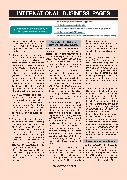INTERNATIONAL BUSINESS PAGES support scheme, instead of (only) a malus-system based on regula- tions (REACH, IED). The eco-de- sign directive should be tailored to- wards this goal. 3. The compulsory textile recycling – by 2025 and even before in some member states – is a challenge, but at the same time an opportunity for the industry to develop a coordi- nated recycling strategy at Euro- pean level. EURATEX proposes to establish European Recycling Hubs (ReHubs) to build an industrial- scale capacity to collect and upcycle 5 million tons of textile waste in Europe. Such initiative can only be successful if accompanied by harmonised and coherent end- of-waste and by-products criteria. 4. EURATEX proposes to introduce Green Public Procurement (GPP) criteria which reflect sustainability costs and related needs of manu- facturing industry. We invite the European Commission own pro- curement departments to lead by example in selecting sustainable textiles. 5. To be successful, the textiles strat- egy must raise awareness among consumers and foster behavioural changestowardsmore sustainability, in relation to the 2020 Consumer Agenda. EURATEX and its members are ready to engage with consumers, e.g. by launching a communication campaign or other awareness initiatives. We can also set targets on sustainable products, e.g. by 2030 at least 50% of suit- able products on the market follow sustainable design principles which need to be agreed, and based on industry accepted standard/ best practices.Strengthen the efficiency of the European T&C industry European textile companies cannot compete on price in this very globalised sector; instead, they need to focus on design, quality and inno- vation, and manage their operations as efficient as possible. The European strategy should identify areas where efficiency gains can be developed. 1. Digitalisation offers enormous op- portunities for the textile industry to become more efficient and at the same time be more sustainable. This applies to digitalisation within the companies as well as digitising the entire supply chain. EURATEX proposes a Digital Transformation Fund for the European T&C indus- try, offering small scale investment support to SMEs who wish to digitalise their operations. 2. As the labour force in T&C is grow- ing older, there is a need to attract young workers and develop new digital and green skills, also for existing workers, to successfully implement this double green and digital transition. As part of the EU Pact for Skills, EURATEX proposes an alliance with VET providers to develop new curricula, promote ap- prenticeships and roll out a com- munication campaign to attract young talents to our industry. Addi- tionally suitable support programs for the upskilling and training of ex- isting qualified employees should be initiated. 3. Despite some success stories i.e. through the textile ETP, the textiles industry is under-represented in most of the EU research and inno- vation programmes, and success rates in various Call for Proposals NCM-OCTOBER 2021 57have been extremely low. EURATEX calls for a dedicated programme that will finance inno- vation in textiles, specifically in sustainable textiles and new mate- rials. 4. Creativity is an essential compo- nent of the European textile indus- try, in particular, its apparel and fashion segment. At the same time, the shift towards sustainable and circular products generates multiple local initiatives. EURATEX wants to encourage and support this start up community - as they are the driv- ers for change - with a dedicated initiative. 5. The efficiency of the European tex- tile producers has been hampered by difficult access to certain raw materials, and sharp price in- creases. The EU regulators should be mindful of the impact of their policies, as some providers e.g. of dye stuffs are no longer available in Europe. The EU should insist on open supply chains with third coun- tries, while at the same time cre- ate a regulatory environment in Eu- rope where textile supplies can still be manufactured (natural and man- made fibres, dye stuffs, etc.). The use of (sustainable) raw materials from Europe should be encouraged and access to sustainable energy supplies at reasonable prices guar- anteed. Increase global market share The textiles industry is one of the most globally exposed sectors of the Euro- pean economy. Annual imports are double the size of exports (Euro 115bln vs. Euro 53bln), while at the same time the share of exports in the companies’ turnover is growing (20% in 2011, to-
